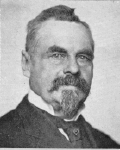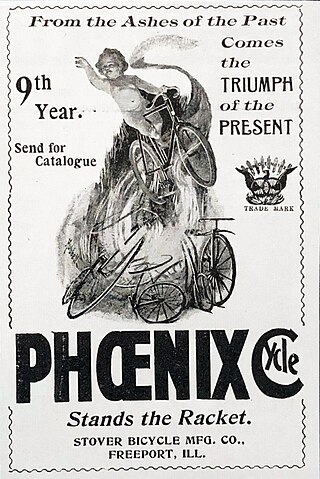
George R. Bidwell (November 8, 1858 - March 16, 1948) was a pioneering bicycle salesman and manufacturer. Active in politics as a Republican, from July 14, 1897, to April 3, 1902, he was Collector of the Port of New York.

George R. Bidwell (November 8, 1858 - March 16, 1948) was a pioneering bicycle salesman and manufacturer. Active in politics as a Republican, from July 14, 1897, to April 3, 1902, he was Collector of the Port of New York.
George Rogers Bidwell was born in Buffalo, New York, on November 8, 1858. [1] His father Charles S. Bidwell was a prominent Buffalo shipbuilder, and his grandfather Benjamin Bidwell, also a shipwright, had constructed several ships for Matthew C. Perry's fleet during the War of 1812. [1] Bidwell was educated in the public schools of Buffalo before beginning his career in bicycle sales and manufacturing. [2]
Bidwell saw his first bicycle at the 1876 Centennial Exposition in Philadelphia and soon bought one for himself. After becoming a proficient bike rider and mechanic, Bidwell later inquired to Albert Augustus Pope, a prominent bicycle manufacturer, about becoming a salesman. Pope told Bidwell about his new Columbia bicycles, one of which Bidwell promptly ordered so he could study its design and workings.
After being brought into Pope's organization, Bidwell proved to be a successful salesman, and Pope promoted him to superintendent of agencies, responsible for supervising the retail locations and franchises that sold the Pope company's products. [3] In 1880, Bidwell became one of the charter members of the newly-formed League of American Wheelmen. [2] In 1881, Bidwell acceded to Pope's request that he move to New York City to take a sales position at E. I. Horsman's sporting goods store, which Pope hoped would result in increased sales. [4] At a conference of the League of American Wheelmen, Bidwell saw a modern safety bicycle, a Rover designed by John Kemp Starley. [5] Bidwell saw immediately that the safety would replace the Penny-farthing or "ordinary" bicycle with a high front wheel that was then the industry standard, and recommended that Pope start production of safeties, but Pope refused. [5] Bidwell then left Pope to start his own corporation, the George R. Bidwell Company, which made safeties and conducted research and development on bicycle design and function. [5]
In 1890, Bidwell's research and development let him to become the first American bicycle maker to use pneumatic tires. [1] He lost a lawsuit that accused him of patent infringement for using pneumatic tires, but won an 1892 appeal of the original ruling against him. [1] Bidwell lost so much money fighting the lawsuit that he needed to acquire outside investors, which he was unable to find. [1] His company went into receivership, and he ceased making pneumatic tires, but kept the company operating until his appointment as Collector. [1]
As a member of the League of American Wheelmen, Bidwell had lobbied for laws protecting cyclists. [2] [6] In 1894, Bidwell became secretary of the New York County Republican Committee, and served for two years. Afterwards, Bidwell took over Republican operations in New York City's Nineteenth Assembly District. [2]
In 1897, Bidwell was appointed as Collector of the Port of New York by President William McKinley. Prior to the adoption of the Sixteenth Amendment, customs duties (tariffs) and excise taxes were the primary sources of federal government revenue, [7] and as the largest port in the United States at the time (by 1910, the port was the busiest in the world), [8] the Port of New York was therefore the single most important source of federal government income. These factors led the office of Collector of the Port of New York to be described as "the prize plum of Federal patronage not only in this State but perhaps in the country, outside of positions in the Cabinet." [9]
In 1901, new President Theodore Roosevelt decided to replace Bidwell with New York State Senator Nevada N. Stranahan, against the wishes of Senator Thomas C. Platt. [10] Bidwell's term in office officially ended when Stranahan was confirmed in April 1902.
After a career in bicycle manufacturing, Bidwell later turned his interests to the automobile and established a factory in Pottstown, Pennsylvania, for making truck engines. [11] During World War I, Bidwell converted his Pottstown factory to the manufacture of artillery shells. [11]
Bidwell died in Brightwaters, New York, on March 16, 1948. [11]
Bidwell's papers are part of the collections of the Hofstra University Library. [1]

A bicycle, also called a pedal cycle, bike, push-bike or cycle, is a human-powered or motor-powered assisted, pedal-driven, single-track vehicle, having two wheels attached to a frame, one behind the other. A bicycle rider is called a cyclist, or bicyclist.

The penny-farthing, also known as a high wheel, high wheeler or ordinary, is an early type of bicycle. It was popular in the 1870s and 1880s, with its large front wheel providing high speeds and comfort.

The League of American Bicyclists (LAB), officially the League of American Wheelmen, is a membership organization that promotes cycling for fun, fitness and transportation through advocacy and education. A Section 501(c)(3) nonprofit organization, the League is one of the largest membership organizations of cyclists in the United States.

Albert Augustus Pope was a Brevet Lieutenant-Colonel in the Union Army. He was an importer, promoter, and manufacturer of bicycles, and a manufacturer of automobiles.

Vehicles that have two wheels and require balancing by the rider date back to the early 19th century. The first means of transport making use of two wheels arranged consecutively, and thus the archetype of the bicycle, was the German draisine dating back to 1817. The term bicycle was coined in France in the 1860s, and the descriptive title "penny farthing", used to describe an "ordinary bicycle", is a 19th-century term.

Horatio Sawyer Earle (1855–1935), known as the "Father of Good Roads" or simply Horatio "Good Roads" Earle, was an American transport engineer.

Thomas Buckland Jeffery was a British emigrant to the United states who co-founded the Gormully & Jeffery company which made the Rambler bicycle. He invented the "clincher" rim which was widely used to fit tires to bicycles and early automobiles, and in 1900 established the Thomas B. Jeffery Company to make automobiles, again using Rambler branding.
Pope Manufacturing Company was founded by Albert Augustus Pope around 1876 in Boston, Massachusetts, US and incorporated in Hartford, Connecticut in 1877. Manufacturing of bicycles began in 1878 in Hartford at the Weed Sewing Machine Company factory. Pope manufactured bicycles, motorcycles, and automobiles. From 1905 to 1913, Pope gradually consolidated manufacturing to the Westfield Mass plant. The main offices remained in Hartford. It ceased automobile production in 1915 and ceased motorcycle production in 1918. The company subsequently underwent a variety of changes in form, name and product lines through the intervening years. To this day, bicycles continue to be sold under the Columbia brand.

Wire wheels, wire-spoked wheels, tension-spoked wheels, or "suspension" wheels are wheels whose rims connect to their hubs by wire spokes. Although these wires are considerably stiffer than a similar diameter wire rope, they function mechanically the same as tensioned flexible wires, keeping the rim true while supporting applied loads. The term suspension wheel should not be confused with vehicle suspension.

American Bicycle Company (1899-1903) was an American bicycle company (Trust) led by Albert Augustus Pope. The company was formed to consolidate the manufacturers of bicycles and bicycle parts. In the 1890s the advancements in bicycle design led to unprecedented demand for the new Safety bicycles. The "American Bicycle Company" trust only lasted for three years.

Airless tires, non-pneumatic tires (NPT), or flat-free tires are tires that are not supported by air pressure. They can be used on small vehicles such as ride-on lawn mowers and motorized golf carts. They also are used on heavy equipment required to operate on sites where risk of tire punctures is high. Tires composed of closed-cell polyurethane foam are also made for bicycles and wheelchairs.

Homer Peter Snyder was an American politician and businessman from New York. Snyder began his business career in the knitting industry, moved to bicycle manufacturing. He left the company to began a political career, entering congress in 1915 and holding office until 1925. He became known for his advocacy on behalf of Native Americans, chairing the Committee on Indian Affairs and introducing the Indian Citizenship Act in 1924.

The Collector of Customs at the Port of New York, most often referred to as Collector of the Port of New York, was a federal officer who was in charge of the collection of import duties on foreign goods that entered the United States by ship at the Port of New York.

Overman Wheel Company was an early bicycle manufacturing company in Chicopee Falls, Massachusetts from 1882 to 1900. It was known for bicycles of higher quality and lower weight than other bicycles of its time. Despite a nationwide bicycle craze in the late 1800s, the company was undercut by lower-priced competition, nearly went bankrupt in 1897, and never recovered from an 1899 fire. The company was sold in 1900.

Western Wheel Works was a Chicago bicycle company started by Adolph Schoeninger in 1866. It was one of the largest bicycle makers in the world. In 1899 it joined a trust which controlled 95 percent of the bicycle manufacturing market.

Indiana Bicycle Company was a bicycle and automobile company in Indianapolis, Indiana, United States. The company made carriages, bicycles and electric vehicles under the name Waverley Cycles. By 1896 the company was producing 350 bicycles every ten hours.

Monarch Cycle Manufacturing Company 1892-1899 was a bicycle manufacturer based in Chicago, Illinois. By 1896 the company became one of the largest manufacturers of bicycles in the world.

Stover Bicycle Manufacturing Company was a bicycle manufacturer in Freeport, Illinois founded by D.C. Stover. The company produced 20,000 bicycles a year in 1897.

James Truesdell Kilbreth was a lawyer, judge and political figure who served as Collector of the Port of New York, an important federal government post in pre-Sixteenth Amendment times, when customs duties and excise taxes were the primary sources of US federal government revenue.